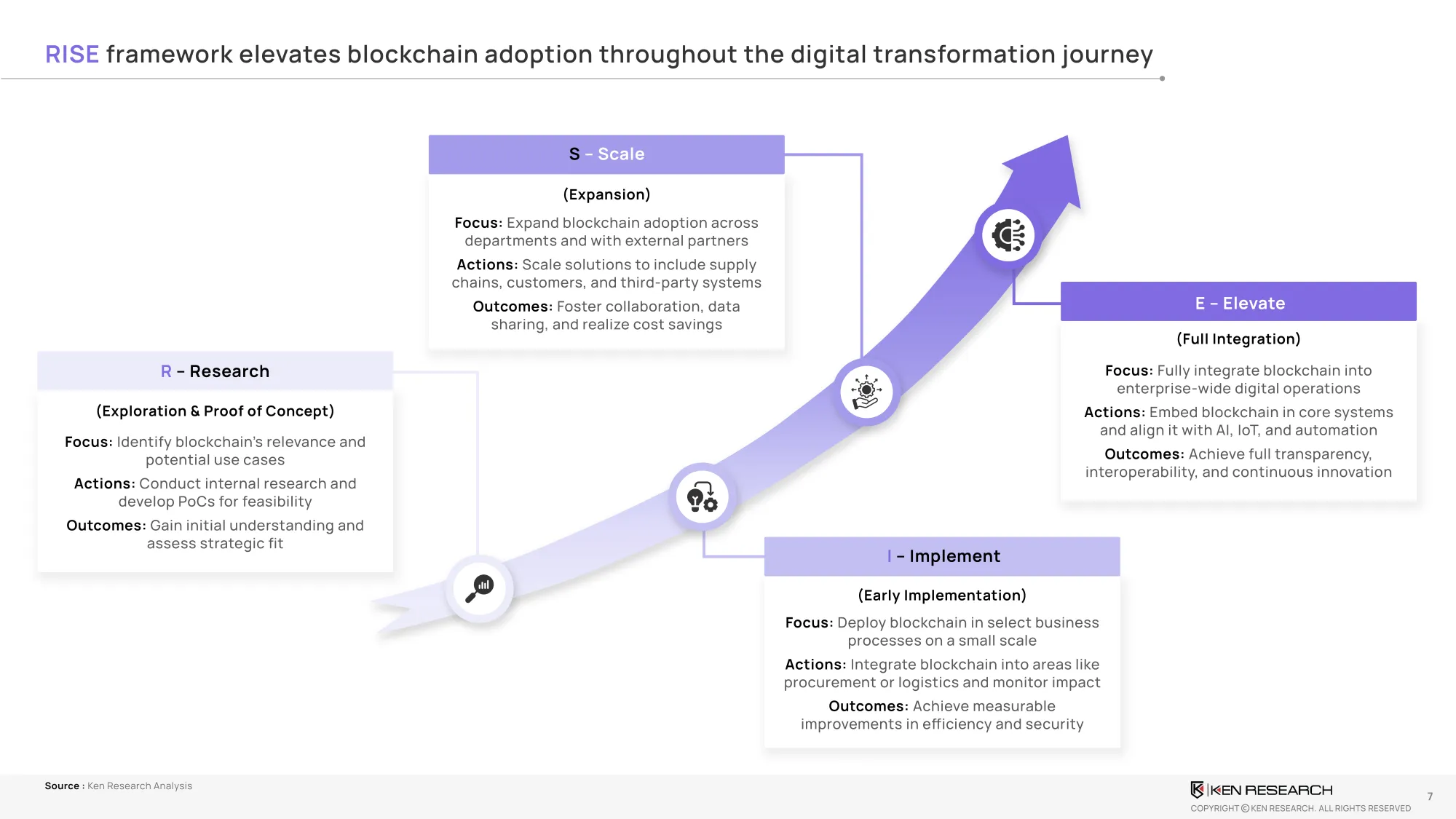Blockchain Technology and Enterprise Use Cases – Strategic Insights for 2024 and Beyond
Explore how blockchain is reshaping enterprise systems in 2024. Unlock strategic use cases and frameworks driving real-world adoption.

Blockchain is no longer confined to cryptocurrency. In 2024, it is a core technology driving digital transformation across industries. From securing digital identity and enabling smart contracts to powering cross-border payments and supply chain transparency, blockchain is reshaping enterprise architecture. This report explores high-impact blockchain use cases, technology adoption trends, and strategic planning frameworks to help organizations integrate blockchain into business models with confidence.
15 Slide Report | Use Case Benchmarks | Industry Adoption Trends | RISE Framework for Implementation
WHO THIS REPORT IS FOR
- CIOs and CTOs planning blockchain integration across enterprise systems
- Strategy leaders and digital transformation officers developing secure and scalable infrastructure
- Executives in BFSI, logistics, telecom, and manufacturing seeking decentralized solutions
- Public sector policy advisors exploring regulatory and data transparency use cases
EXECUTIVE SUMMARY
Blockchain is becoming a fundamental layer in the modern tech stack. No longer limited to digital assets, it is enabling enterprises to build secure, interoperable, and automated systems. Its relevance is most evident in areas requiring trustless verification, tamper-proof data, and cross-organizational coordination.
Key drivers of blockchain adoption in 2024 include:
- Growth of multi-cloud, AI, and IoT ecosystems requiring secure, traceable data
- Escalating regulatory pressure around compliance and auditability
- Rising demand for tokenization and decentralized authentication models
A 2023 Deloitte global blockchain survey reported that 93% of enterprise leaders see blockchain as critical to long-term success, while 82% are actively investing or piloting blockchain programs.
BLOCKCHAIN BENEFITS FOR ENTERPRISES
Blockchain delivers measurable value in key enterprise dimensions:
- Data Integrity: Immutable logs, consensus validation, and audit trails enable tamper-proof data governance across partner ecosystems
- Security and Compliance: Smart contract execution reduces human error, while permissioned blockchains enable compliance with GDPR and financial regulations
- Interoperability: Blockchain acts as a shared protocol layer across ERP, CRM, and vendor platforms—cutting integration costs by up to 40%
- Efficiency: Smart contracts streamline workflows by automating settlement, validation, and reporting tasks across multi-party systems
INDUSTRY ADOPTION OVERVIEW
Ken Research’s BRIDGE Matrix outlines blockchain maturity across 10 sectors:
- Advanced Adoption: Banking, Financial Services, IT
- Emerging Use Cases: Telecom, Power, Healthcare, Logistics
- Early-Stage Adoption: Manufacturing, Education, Retail, Real Estate
A 2024 industry-wide analysis revealed that over 40% of telecom firms and 52% of logistics players have integrated blockchain into at least one business-critical workflow.
ENTERPRISE BLOCKCHAIN USE CASES IN 2024
Banking and Financial Services:
- Cross-border settlement, asset tokenization, KYC authentication, smart contract escrow. SWIFT’s gpi blockchain prototype reduced settlement windows from 3 days to 30 seconds.
Telecom and Technology:
- SIM registration via blockchain identity, fraud detection, peer-to-peer credit exchange. Blockchain-enabled authentication reduced identity fraud by 18% for Tier 1 telcos.
Supply Chain and Logistics:
- Product provenance, carbon tracking, real-time shipment validation, decentralized freight matching. IBM and Maersk’s TradeLens processed 30 million documents across 160 ports globally.
Government and Public Sector:
- Land registry, citizen ID verification, welfare disbursement, decentralized voting pilots. Estonia’s e-Government stack uses blockchain for health records and national ID management.

THE RISE FRAMEWORK FOR BLOCKCHAIN ADOPTION
RISE is a phased blockchain maturity framework used by CIOs and enterprise architects:
- Research: Analyze sector readiness, risks, and internal inefficiencies
- Implement: Launch PoCs in procurement, KYC, or ledger integration; partner with Web3 vendors
- Scale: Expand from isolated pilots to enterprise-wide integration (ERP, compliance, audit)
- Elevate: Link blockchain to IoT sensors, AI models, and enterprise automation layers
Companies that adopt a RISE-aligned model report 30–50% faster transition from pilot to production, with significantly lower CAPEX wastage.

BLOCKCHAIN VS TRADITIONAL DATABASES – WHAT ENTERPRISES NEED TO KNOW
|
Feature |
Traditional
Database |
Blockchain |
|
Architecture |
Centralized |
Distributed / Decentralized |
|
Trust Model |
Trust in Central Authority |
Trustless / Consensus-Based |
|
Data Mutability |
Mutable |
Immutable |
|
Audit & Compliance |
Manual or Batch Logging |
Built-In Audit Trails
(Real-Time) |
|
Interoperability |
Vendor-Limited |
Open Standards / Smart Contracts |
|
Downtime Risk |
Single Point of Failure |
Distributed Redundancy |
Blockchain is not a replacement for all databases—but for workflows involving multiple parties, cross-border transactions, compliance automation, or digital asset custody—it provides clear strategic advantage.
STRATEGIC INSIGHTS FROM LIVE DEPLOYMENTS
- Bank of Thailand and HKMA launched Project Inthanon-LionRock for CBDCs, reducing settlement latency by 50%
- Telefonica deployed blockchain for SIM authentication across LATAM markets, reporting 25% fraud drop
- Walmart and IBM cut food traceability timelines from 7 days to under 2.5 seconds with a blockchain-integrated supply chain
- Indian Railways now uses blockchain ledgers to track cargo, reduce delays, and validate CO2 emissions data
What is the Conclusion?
Blockchain is a foundational digital technology—on par with the cloud and AI. While not every process needs it, the ones that do can unlock enterprise-wide performance gains, compliance readiness, and ecosystem interoperability. Organizations that adopt now, with strategic intent, will shape the next generation of digital infrastructure.


